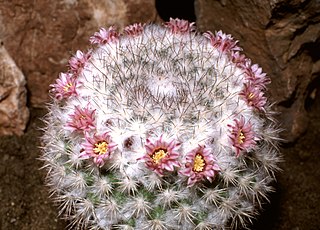
Mammillaria is one of the largest genera in the cactus family (Cactaceae), with currently 200 known species and varieties recognized. Most of the mammillarias are native to Mexico, while some come from the Southwestern United States, the Caribbean, Colombia, Guatemala, Honduras and Venezuela. The common name "pincushion cactus" refers to this genus and the closely-related Escobaria.

Cochemiea dioica, also called the strawberry cactus, California fishhook cactus, strawberry pincushion or fishhook cactus, is a cactus species of the genus Cochemiea. Its common name in Spanish is biznaga llavina. Temperature along with precipitation are consequential factors in distributing plant species.

Mammillaria zeilmanniana is a species of cactus. It is endemic to Mexico, where it is known only from Guanajuato. It grows in a narrow canyon usually near water where there is high humidity, its total population is fewer than 250 individuals. It is threatened by illegal collection for the horticultural trade. Recent studies link this species to Mammillaria crinita.

Mammillaria spinosissima, also known as the spiny pincushion cactus, is a species of flowering plant in the cactus family Cactaceae, endemic to the central Mexican states of Guerrero and Morelos, where they grow at elevations of approximately 1,600 to 1,900 metres. The species was described in 1838 by James Forbes, gardener of the Duke of Bedford. Botanist David Hunt collected a specimen in 1971, when he located one near Sierra de Tepoztlan, Mexico.

Mammillaria magnimamma, common name Mexican pincushion, is a species of flowering plant in the cactus family Cactaceae.

Mammillaria discolor is a species of cactus in the subfamily Cactoideae.
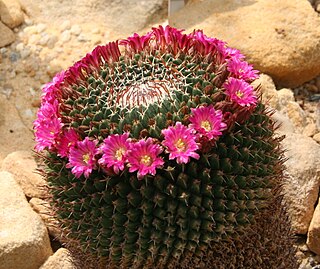
Mammillaria mystax is a species of cactus in the subfamily Cactoideae. It is endemic to the Mexican states of Hidalgo, Oaxaca and central Puebla.

Mammillaria carnea is a species of cactus in the subfamily Cactoideae.
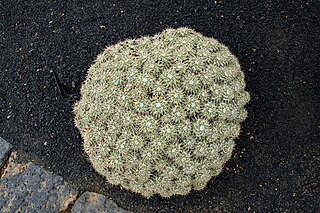
Mammillaria compressa, commonly called mother of hundreds, is a species of cactus in the subfamily Cactoideae. It is native to northern and southern Mexico, and is cultivated as an ornamental plant. It blooms in the winter and early spring, with bell-shaped flowers that range from a purplish pink to red color. Its curved spines were traditionally used as hooks for fishing.
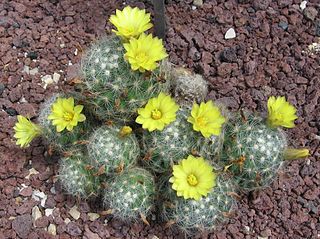
Mammillaria baumii is a species of cactus in the subfamily Cactoideae. It is endemic to Mexico. It was named for botanist Hugo Baum.
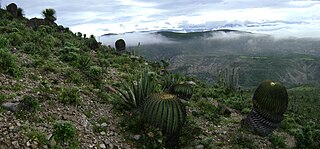
The Tehuacán-Cuicatlán biosphere reserve is a protected natural area located in southeastern Mexico. Its name derives from its two main locations: Cuicatlán and Tehuacán, in the latter are their administrative offices, covers 490,186 hectares distributed among 21 municipalities in the state of Puebla and Oaxaca.
Mammillaria elegans is a species of cacti in the tribe Cacteae. It is native to Mexico. Mammillaria elegans A.P. de Candolle 1828. is a 'nomen confusum' also applied to Mammillaria haageana subsp. elegans and refers both to Mammillaria geminispina with latex in the stem and to Mammillaria haageana, without latex in the stem Habit: Solitary, seldom branching cactus.
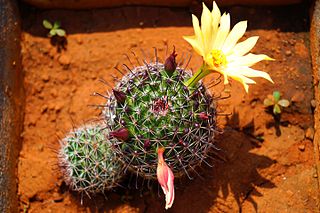
Mammillaria beneckei is a species of cacti in the tribe Cacteae. It is native to Mexico.

Mammillaria heyderi is a species of cactus in the tribe Cacteae. It is endemic to Sonora and Chihuahua in Mexico and New Mexico, Arizona, Texas, and Oklahoma in the United States.
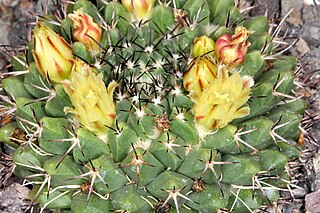
Mammillaria karwinskiana is a species of cacti in the tribe Cacteae. It is native to Mexico.

Mammillaria haageana is a species of cacti in the tribe Cacteae. It is native to Mexico, where it is found commonly, and is widespread throughout much of the country.
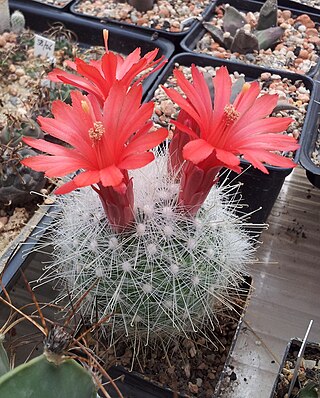
Mammillaria senilis is a species of cacti in the tribe Cacteae. It is native to Mexico, where it is found in the states of Chihuahua, Durango, Jalisco, Nayarit, Sinaloa and in south Zacatecas.

Mammillaria pringlei, called the lemon ball, is a species of cactus in the genus Mammillaria, native to Mexico, from Querétaro through to Veracruz and on to México State. It has gained the Royal Horticultural Society's Award of Garden Merit.

Mammillaria petterssonii is a species of cactus in the genus Mammillaria, native to northeast and southwest Mexico. It has gained the Royal Horticultural Society's Award of Garden Merit.

Mammillaria hernandezii is a species of cacti in the tribe Cacteae. It is native to Mexico where it has a disjointed distribution in a small area of upland tropical pine scrub. There are estimated to be fewer than 500 plants in the wild and is classified as endangered.






















